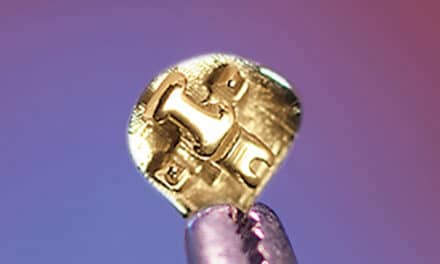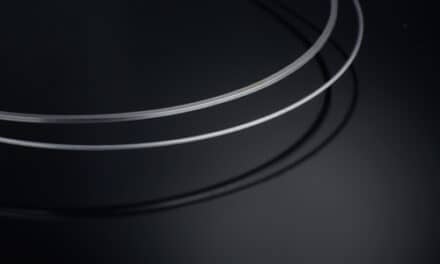by Carol A. Jahn, RDH, MS
Over-the-counter products for improving gingival health in orthodontic patients
 |
A key element in a successful orthodontic outcome is good self care. Yet the presence of brackets and wires can make daily hygiene challenging, even for the most motivated patient. Traditional measures such as using a floss threader can be time-consuming, tedious, and in many cases too difficult for young hands. Powered and other alternative products may be more appealing for patients of any age. This article will discuss the benefits of over-the-counter (OTC) products for improving gingival health in patients with orthodontic appliances.
Going for Good: Incorporating a Power Toothbrush
Over the past 20 years, power toothbrushes have become a mainstay in daily self care. It is widely documented and accepted that they can enhance plaque removal and reduce gingivitis.1 Power brushes are readily available and easy to use. Many have timers that can help extend brushing time to the recommended 2 minutes.
Several studies have looked at the use of power brushes with orthodontic patients and found encouraging results.2–4 Two studies of noncompliant adolescents in orthodontic treatment found that a sonic toothbrush was more effective at reducing plaque and bleeding than a manual toothbrush was.2,3 Similarly, oscillating brushes have been shown to remove more plaque than manual brushes on orthodontic patients.4
Encouraging Better Results: Mouthrinsing
OTC mouthrinses have become increasingly popular in recent years. Several studies have demonstrated the anti-plaque, anti-gingivitis effects of essential oil mouthrinses over a 6-month time frame.5,6 In general, mouthrinses are perceived as easy to use and can help patients access difficult-to-reach areas supragingivally.5,7 In combination with toothbrushing, mouthrinsing can help orthodontic patients achieve a greater level of gingival health than toothbrushing alone.
Studies on essential oil use among orthodontic patients are rare or nonexistent. Of interest to orthodontic patients is the fact that essential oil has been found to be at least as good as dental floss for the control of interproximal gingivitis and plaque.8,9 Both Sharma et al and Barouth et al found that the essential oil mouthrinse was significantly more effective at removing interproximal plaque.8,9 Barouth et al found superior gingivitis reduction over dental flossing for the essential oil mouthrinse, while Sharma et al found similar results for both products.
Achieving the Best Results: Dental Water Jets
The first dental water jet was introduced in 1962. Early studies demonstrated its ability to reduce calculus and gingivitis. Over time, the scientific evidence has grown to show efficacy for reducing plaque, periodontal pathogens, and bleeding on probing, as well as modulating the host response.10 Dental water jets provide the greatest potential of any self care device for subgingival access.7,11,12 The dental water jet can reach areas often missed by brushes, interdental devices, and rinses. It is gentle on swollen and tender tissue, effectively reducing those symptoms.
Several studies have shown that the dental water jet is an effective tool for patients in orthodontic therapy.13–15 Burch et al found that the addition of a dental water jet to manual or power toothbrushing reduced bleeding and gingivitis better than manual toothbrushing alone.13 Hurst et al found that using a dental water jet once daily with water in addition to toothbrushing was 80% more effective than toothbrushing and rinsing in reducing total aerobic flora and 60% more effective in reducing the lactobacillus counts.14
 |
| Carol A. Jahn, RDH, MS |
A recent study of 105 adolescents ranging in age from 11 to 17 years compared a dental water jet with a tip designed specifically for orthodontic appliances plus manual toothbrushing to manual toothbrushing plus floss via floss threader and manual toothbrushing alone. The addition of the dental water jet reduced 3.76 times more plaque than flossing with a floss threader and 5.83 times more plaque than manual toothbrushing alone. The dental water jet also provided a significantly better reduction in bleeding—84.5% from baseline—which was 26% better than the results achieved with dental floss.15
These results confirm Barnes et al, who found that once-daily irrigation with water, added to either a manual or power brushing routine, was an effective alternative to dental floss for the reduction of bleeding, gingivitis, and plaque—and in some cases provided superior results for reducing bleeding and gingivitis.16
In conclusion, OTC products ranging from power toothbrushes to mouthrinses to dental water jets can play a key role in improving and maintaining oral health for patients in orthodontic therapy.
Carol A. Jahn, RDH, MS, is manager of Professional Education and Communications for Water Pik Inc. She has presented more than 200 continuing education courses on topics such as periodontics, diabetes, and oral and general health considerations. She has published more than 60 papers and contributed to six textbooks. She can be reached at
References
- Asadoorian J. CDHA Position paper on tooth brushing. Canadian Journal of Dental Hygiene. 2006;40(5):232-248.
- Ho HP, Niederman R. Effectiveness of the sonicare toothbrush on reduction of plaque, gingivitis, probing pocket depth, and subgingival bacteria in adolescent orthodontic clients. J Clin Dent. 1997;8(1):15-19.
- White LW. Efficacy of a sonic toothbrush in reducing plaque and gingivitis in adolescent clients. J Clin Orthod. 1996;30(2):85-90.
- Tripeneers, LM, Wijgaerts IA, Grognard NA, Dermaut LR, Adriaens PA. Effect of electric toothbrushes versus manual toothbrushes on removal of plaque and periodontal status during orthodontic treatment. Am J Orthod Dentofacial Orthop. 1997;111(5):492-497.
- Asadoorian J. CDHA Position paper on commercially available over-the-counter oral rinsing products. Canadian Journal of Dental Hygiene. 2006;40(4):1-13.
- Gunsolley JC. A meta-analysis of six-month studies of antiplaque and antigingivitis agents. J Am Dent Assoc. 2006;137(12):1649-1657.
- Braun RE, Ciancio SG. Subgingival delivery by an oral irrigation device. J Periodontol. 1992;63:469-472.
- Sharma N, Charles CH, Qaquish JG, Zhao Q, Kumar LD. Comparative effectiveness of an essential oil mouthrinse and dental floss in controlling interproximal gingivitis and plaque. Am J Dent. 2002;15:351-355.
- Bauroth K, Charles CH, Mankodi SM, Simmons K, Zhao Q, Kuman LD. The efficacy of an essential oil antiseptic mouthrinse vs. dental floss in controlling interproximal gingivitis: A comparative study. J Am Dent Assoc. 2003;134:359-365.
- American Academy of Periodontology: Position Paper: The role of supra- and subgingival irrigation in the treatment of periodontal diseases. J Periodontol. 2005:76:2015-2027. American Academy of Periodontology Web site. http://www.perio.org. Accessed August 25, 2008.
- Eakle S, Ford C, Boyd RL. Depth of penetration into periodontal pockets with oral irrigation. J Clin Periodontol. 1986;13(1):39-44.
- Williams KB, Cobb CM, Taylor HJ, Brown AR, Bray KK. Effect of sonic and mechanical toothbrushes on subgingival microbial flora: A comparative in vivo scanning electron microscopy study of 8 subjects. Quintessence Int, 2001; 32(2):147-154.
- Burch JG, Lanese R, Ngan P. A two-month study of the effects of oral irrigation and automatic toothbrush use in an adult orthodontic population with fixed appliances. Am J Orthod Dentofac Orthop. 1994;106(2):121-126.
- Hurst JE, Madonia JV. The effect of an oral irrigating device on the oral hygiene of orthodontic patients. J Am Dent Assoc. 1970;81:678-683.
- Sharma NC, Lyle DM, Qagish JG, Galustians J, Schuller R. The effect of a dental water jet with orthodontic tip on plaque and bleeding in adolescent patients with fixed orthodontic appliances. Am J Orthod Dentofacial Orthop. 2008;133(4):565-571.
- Barnes CM, Russell CM, Reinhardt RA, Payne JB, Lyle DM. Comparison of irrigation to floss as an adjunct to toothbrushing: effect on bleeding, gingivitis and supragingival plaque. J Clin Dent. 2005;16(3):71-77.





